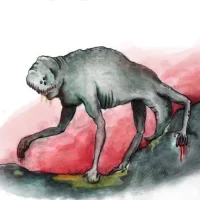Amikuk : The Earth-Swimming Spirit of Yup’ik Mythology
Listen
At a glance
| Description | |
|---|---|
| Origin | Yupik Mythology |
| Classification | Spirits |
| Family Members | N/A |
| Region | United States of America |
| Associated With | Fear, Shapeshifting, Trickery |
Amikuk
Introduction
The Amikuk is a fearsome and mysterious creature deeply rooted in the mythology of the Yup’ik people of Alaska. This supernatural being is unlike any other in Arctic folklore—it is both a sea and earth dweller, capable of moving effortlessly through water and solid ground. Its legend serves as a powerful reminder of the unpredictable and often perilous relationship between humans and nature in the harsh Arctic world. In Yup’ik oral tradition, the Amikuk is not merely a monster—it is a spiritual embodiment of danger, transformation, and respect for the unseen forces that govern the environment. Hunters and travelers feared its presence, yet its myth carried lessons about humility, caution, and survival in the unforgiving tundra and seas.
Physical Traits
Descriptions of the Amikuk’s appearance vary among storytellers, reflecting the fluid nature of oral tradition. It is most commonly depicted as a long, sinewy, humanoid creature with leathery, dark skin that glistens like wet seal hide. Its body is said to be slick, hairless, and muscular, with four thin, flexible arms ending in claw-like fingers. The creature’s eyes glow an eerie reddish-orange in the darkness, and its mouth is filled with rows of sharp teeth perfect for grasping prey.
In some accounts, it is portrayed as part human and part sea creature, moving with an undulating motion reminiscent of an eel or octopus. On land, it can “swim” beneath the ground, disturbing the soil above it and creating a rhythmic thumping sound that warns of its approach. Some Yup’ik hunters described the sensation of the ground trembling beneath their feet as a sign that the Amikuk was near. The dual nature of its body—adapted to both water and earth—symbolizes its mastery over elements and its connection to both physical and spiritual realms.
Family
Unlike many mythological beings with established genealogies, the Amikuk is a solitary entity. It is not associated with gods, spirits, or ancestors but instead exists as an independent, primordial force of nature. In Yup’ik cosmology, it functions more as an elemental being—neither divine nor demonic—representing the unpredictability of the Arctic environment itself. Its lack of family ties underscores its role as an isolated predator, eternally roaming between the worlds of land and sea.
This solitude mirrors the Yup’ik view of balance in nature: every force has its place and purpose, even those that threaten humans. The Amikuk’s existence serves as a warning rather than an embodiment of evil, teaching that the natural world demands respect, vigilance, and an understanding of one’s limits.
Other names
The Amikuk is known by several names across Yup’ik-speaking regions, reflecting the diversity within Alaska’s indigenous communities. Variations such as A-mi’-kuk, Amikut, Amikuut, and Qamungelriit appear in different oral traditions. The term Qamungelriit is particularly associated with its human-like form, a guise it adopts when interacting with people. In this state, it might appear as a solitary traveler pulling a sled across the ice, testing those who encounter it.
These name variations emphasize the creature’s shapeshifting nature and how each community interpreted it based on local geography—whether encountered beneath the frozen rivers, along the coast, or under tundra soil. The consistent presence of the name “Amikuk” across dialects demonstrates its cultural importance and widespread fear among the Yup’ik people.
Powers and Abilities
The Amikuk’s powers are vast and terrifying, blending physical prowess with supernatural capabilities. Its most renowned ability is its power to move through earth as if it were water, earning it the name “earth-swimmer.” When it hunts, it can cause the ground to liquefy, trapping prey in a quicksand-like surface before emerging to seize them. This terrifying ambush made it a symbol of unseen danger, particularly for hunters who traveled alone.
In water, it is equally formidable. The Amikuk attacks from beneath the ice, using its elongated limbs to pull down kayaks and drag victims into the freezing depths. It embodies the unpredictable nature of Arctic seas—silent, deceptive, and deadly.
Perhaps its most fascinating ability is shapeshifting. In some stories, the Amikuk transforms into a human, testing the morality and patience of those it meets. When it approaches as a traveler, it offers gifts that grow increasingly valuable. The traditional belief warns that one must never face or speak to it until it stops offering gifts. Accepting its final offering could bring immense fortune—but at the cost of one’s freedom or sanity, becoming bound to the spirit’s will.
The Amikuk is also said to multiply when attacked. If struck by a weapon, it splits into multiple identical beings, surrounding its aggressor. This ability represents the futility of aggression against nature and the idea that violence only multiplies one’s dangers.
Modern Day Influence
Today, the Amikuk remains a significant figure in both Yup’ik cultural expression and broader mythological discussions. Traditional artists continue to create Amikuk masks and carvings, some of which are preserved in major institutions like the Portland Art Museum and the Anchorage Museum. These artworks serve as both aesthetic creations and educational tools, teaching younger generations about traditional beliefs and the importance of coexistence with the environment.
Contemporary Yup’ik artists such as Phillip Charette have reimagined the Amikuk through modern sculpture and performance, blending ancestral mythology with current themes of climate change and cultural survival. The creature’s dual existence—between land and water—mirrors the tension between tradition and modernity in indigenous life today.
Beyond Alaska, the Amikuk has entered global folklore circles, appearing in online mythological databases, documentaries, and even fantasy video games that draw inspiration from indigenous lore. Scholars and enthusiasts often compare it to other shape-shifting entities like the Wendigo of Algonquian mythology or the Skinwalker of Navajo tradition, though the Amikuk’s connection to the land-sea boundary makes it unique among them.
For the Yup’ik people, however, the Amikuk’s significance is not in horror or fiction—it is a moral compass. Its tales are used to teach children respect for nature, caution while traveling, and humility before unseen forces. In a modern context, its story aligns with environmental and cultural preservation movements, symbolizing the need to live in harmony with a fragile and changing world.
Related Images
Source
Amikuk. (2024, July 26). In Wikipedia. Retrieved November 6, 2025, from https://en.wikipedia.org/wiki/Amikuk
Leanbh Pearson. (2023, April 18). Inuit Folklore: The Amikuk. Retrieved November 6, 2025, from https://leanbhpearson.com/2023/04/19/inuit-folklore-the-amikuk/
The Creature Codex. (n.d.). Amikuk. Retrieved November 6, 2025, from https://thecreaturecodex.wordpress.com/2016/12/16/amikuk/
Portland Art Museum. (n.d.). Traditional Yupik Amikuk mask by Aarnaquq (Phillip John Charette). [Museum exhibit].
Wikipedia contributors. (2007, April 10). Yup’ik. In Wikipedia. Retrieved November 6, 2025, from https://en.wikipedia.org/wiki/Cup’ik_people
Offbeat Folklore Wiki. (2023). Amikuk. https://offbeat.fandom.com/wiki/Amikuk
Fienup-Riordan, A. (1994). Boundaries and Passages: Rule and Ritual in Yup’ik Eskimo Oral Tradition. University of Oklahoma Press.
Charette, P. (2002). Masks of the Amikuk: Contemporary Interpretations of Yupik Mythology. Alaska Native Arts Journal, 14(2), 45–52.
Nelson, E. W. (1899). The Eskimo about Bering Strait. Bureau of American Ethnology.
Jolles, C. Z. (2002). Faith, Food, and Family in a Yupik Whaling Community. University of Washington Press.
Frequently Asked Questions
Who is Amikuk in Yup’ik mythology?
Amikuk is a supernatural being from the mythology of the Yup’ik people of Alaska. It is known as a shapeshifting creature that can move effortlessly through both water and solid ground, often depicted as a terrifying hunter that preys on humans, especially those who disrespect nature or travel alone.
What does the Amikuk look like?
The Amikuk is described as a long, humanoid creature with dark, leathery skin, four thin arms ending in sharp claws, and glowing reddish-orange eyes. Its slick, hairless body allows it to “swim” through the earth and water, and it often appears in eerie, half-human, half-sea creature forms.
What powers does the Amikuk have?
Amikuk possesses the power to swim through land as if it were water, create quicksand traps to catch prey, and shapeshift into human form. In some tales, it can also multiply when attacked and lure people with valuable gifts that bind them to its will.
Is the Amikuk evil?
In Yup’ik belief, the Amikuk is not inherently evil but represents the unpredictable and dangerous aspects of nature. Its attacks and tricks serve as moral lessons about humility, respect, and survival in the harsh Arctic environment.
How is the Amikuk represented today?
Today, Amikuk remains a vital part of Yup’ik cultural heritage. It appears in traditional masks, carvings, and modern art, symbolizing environmental respect and indigenous wisdom. It has also inspired appearances in folklore studies, museums, and modern fantasy media.







